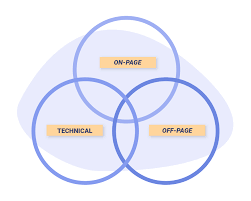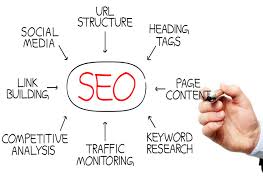Unlocking the Potential of On-Page SEO Content: A Guide to Optimising Your Website
The Power of On-Page SEO Content
When it comes to search engine optimisation (SEO), on-page content plays a crucial role in determining the visibility and ranking of your website. On-page SEO content refers to the text, images, and multimedia elements that are present on individual web pages and are optimised for search engines.
Why On-Page SEO Content Matters
Effective on-page SEO content not only helps search engines understand the relevance of your website to specific keywords but also enhances the user experience. By creating high-quality, relevant, and engaging content, you can attract more organic traffic to your site and keep visitors engaged.
Key Elements of On-Page SEO Content
Keywords: Incorporating relevant keywords strategically throughout your content helps search engines identify the main topics of your web pages.
Title Tags: Optimising title tags with primary keywords can improve click-through rates from search engine results pages (SERPs).
Meta Descriptions: Compelling meta descriptions can entice users to click on your link in search results.
Headings: Using headings (H1, H2, etc.) helps structure your content and improve readability for both users and search engines.
Internal Links: Linking to other relevant pages within your website can improve navigation and increase dwell time.
Tips for Optimising On-Page SEO Content
To maximise the impact of your on-page SEO content, consider the following tips:
- Create unique and valuable content that addresses user intent.
- Avoid keyword stuffing and focus on natural incorporation of keywords.
In Conclusion
In conclusion, on-page SEO content is a fundamental aspect of any successful SEO strategy. By prioritising the creation of high-quality, relevant content that is optimised for both users and search engines, you can enhance your website’s visibility, attract more organic traffic, and ultimately achieve better rankings in search results.
Essential FAQs About Optimising On-Page SEO Content for Your Website
- What is on-page SEO content?
- Why is on-page SEO content important for websites?
- How can I optimise keywords in my on-page SEO content?
- What role do title tags play in on-page SEO?
- How do meta descriptions impact on-page SEO?
- Why are headings crucial for on-page SEO?
- What is the significance of internal links in on-page SEO content?
- How can I create unique and valuable on-page SEO content?
- Why is it essential to update and refresh on-page SEO content regularly?
What is on-page SEO content?
On-page SEO content refers to the textual, visual, and multimedia elements that are present on individual web pages and are optimised to improve the website’s visibility and ranking in search engine results. This content includes strategically placed keywords, meta tags, headings, internal links, and other elements that help search engines understand the relevance of the page to specific queries. By creating high-quality, engaging on-page SEO content that is relevant to users’ search intent, website owners can attract organic traffic, enhance user experience, and increase their chances of ranking higher in search engine results pages.
Why is on-page SEO content important for websites?
Effective on-page SEO content is vital for websites because it serves as the foundation for attracting organic traffic and improving search engine rankings. By optimising on-page content with relevant keywords, informative meta descriptions, and structured headings, websites can enhance their visibility and relevance to search engines. Quality on-page SEO content not only helps search engines understand the context of web pages but also provides valuable information to users, thereby improving user experience and engagement. Ultimately, prioritising on-page SEO content ensures that websites can effectively communicate their purpose, attract target audiences, and achieve sustainable online success.
How can I optimise keywords in my on-page SEO content?
Optimising keywords in your on-page SEO content is essential for improving your website’s visibility and relevance to search engines. To effectively optimise keywords, start by conducting thorough keyword research to identify relevant terms and phrases that align with your content and target audience. Once you have selected your keywords, strategically incorporate them into your title tags, meta descriptions, headings, and body content while maintaining a natural flow. Avoid keyword stuffing, as this can harm the user experience and lead to penalties from search engines. By creating high-quality, informative content that seamlessly integrates targeted keywords, you can enhance the discoverability of your website and attract organic traffic interested in your offerings.
What role do title tags play in on-page SEO?
Title tags play a crucial role in on-page SEO by serving as the clickable headline that appears in search engine results pages (SERPs). These tags not only provide a concise summary of the content on a web page but also help search engines understand the relevance of the page to specific keywords. Optimising title tags with relevant keywords can significantly impact click-through rates and improve the overall visibility and ranking of a website. By crafting compelling and keyword-rich title tags, website owners can enhance their SEO efforts and attract more organic traffic to their site.
How do meta descriptions impact on-page SEO?
Meta descriptions play a crucial role in on-page SEO by providing a concise summary of a web page’s content to both search engines and users. These snippets appear below the page title in search engine results, influencing click-through rates and user engagement. Optimising meta descriptions with relevant keywords and compelling language can attract more clicks, improving the visibility and ranking of the page. Additionally, well-crafted meta descriptions can enhance the user experience by accurately describing the content of the page, setting clear expectations for visitors before they click through. In essence, meta descriptions are a vital component of on-page SEO strategy, influencing both search engine algorithms and user behaviour.
Why are headings crucial for on-page SEO?
Headings play a crucial role in on-page SEO for several reasons. Firstly, headings help to structure the content of a web page, making it easier for both users and search engines to understand the hierarchy and main topics covered. Search engines use headings (such as H1, H2, etc.) to determine the relevance of the content to specific keywords, which can impact the ranking of the page in search results. Additionally, headings provide visual cues that improve readability and user experience, helping visitors to quickly scan and navigate through the content. By optimising headings with relevant keywords and maintaining a logical structure, websites can enhance their SEO performance and attract more organic traffic.
What is the significance of internal links in on-page SEO content?
Internal links play a crucial role in on-page SEO content by connecting different pages within a website and establishing a hierarchical structure that search engines can crawl and index effectively. By strategically incorporating internal links, website owners can guide both users and search engines to relevant content, improving navigation and enhancing the overall user experience. Internal links help distribute link equity throughout the site, boosting the visibility of important pages and increasing the likelihood of higher rankings in search engine results. Proper use of internal links can also increase dwell time on the website, reduce bounce rates, and encourage visitors to explore more content, ultimately contributing to improved SEO performance.
How can I create unique and valuable on-page SEO content?
Creating unique and valuable on-page SEO content requires a strategic approach that combines creativity, relevance, and optimisation. Start by conducting thorough keyword research to identify relevant topics and phrases that align with your target audience’s search intent. Craft original and engaging content that provides valuable insights, answers questions, or solves problems for your readers. Structure your content with clear headings, subheadings, and bullet points to improve readability and user experience. Incorporate keywords naturally throughout the content while avoiding keyword stuffing. Regularly update and refresh your content to ensure it remains current and relevant to both users and search engines. By focusing on quality, relevance, and user experience, you can create on-page SEO content that stands out and drives organic traffic to your website.
Why is it essential to update and refresh on-page SEO content regularly?
Regularly updating and refreshing on-page SEO content is essential for maintaining the relevance and effectiveness of your website. Search engines favour fresh and up-to-date content, as it signals to them that your site is active and continuously providing value to users. By regularly revisiting and updating your on-page SEO content, you can ensure that it remains aligned with current search trends, user preferences, and algorithm updates. This practice not only improves your chances of ranking higher in search results but also enhances user experience by offering timely and accurate information. Keeping your content fresh demonstrates your commitment to quality and credibility, ultimately contributing to the long-term success of your SEO efforts.

